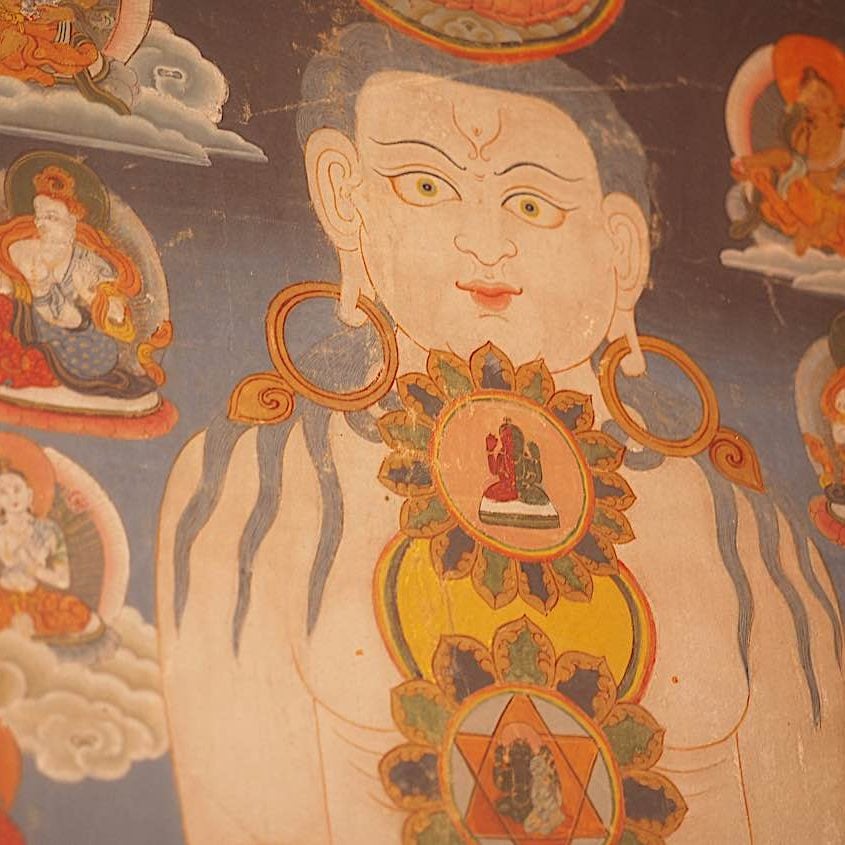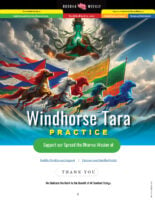Five Wisdom Dakinis: “The source of the five activities is the dakini” —Padmasambhava: full feature, documentary video and more

What are the Five Wisdom Dakinis? Why are they central to Tibetan Buddhist practice? Why are they associated with activity practices— peaceful, increasing, magnetizing, subjugating, and supreme activities — such as Chod?
The great Padmasambhava Guru Rinpoche answers it best:
“The source of activity is the dakini and there are five kinds of activities, peaceful, increasing, magnetizing, subjugating, and the supreme activity. The primary way to perfect these is through dakini practices, and among dakinis, there are the wisdom dakinis, in space, and worldly dakinis. These vast collections of practices can be condensed into those of the three roots, lama, yidam, and dakini.
Watch the amazing 5 Wisdom Dakinis Buddha Weekly video with chanting of the five mantras of the Dakinis by the amazing Yoko Dharma:
Note: Pema Khandro (Tib.) mentioned by Guru Rinpoche translates as Padma Dakini (Sanskrit. See below section for information), the Red Dakini of the Lotus Family (Amitabha’s family). Not to be confused with the teacher quoted below, Pema Khandro Rinpoche.
(Note: Amazon affiliate link. Price is unchanged, but we may earn a commission to offset our hosting costs.
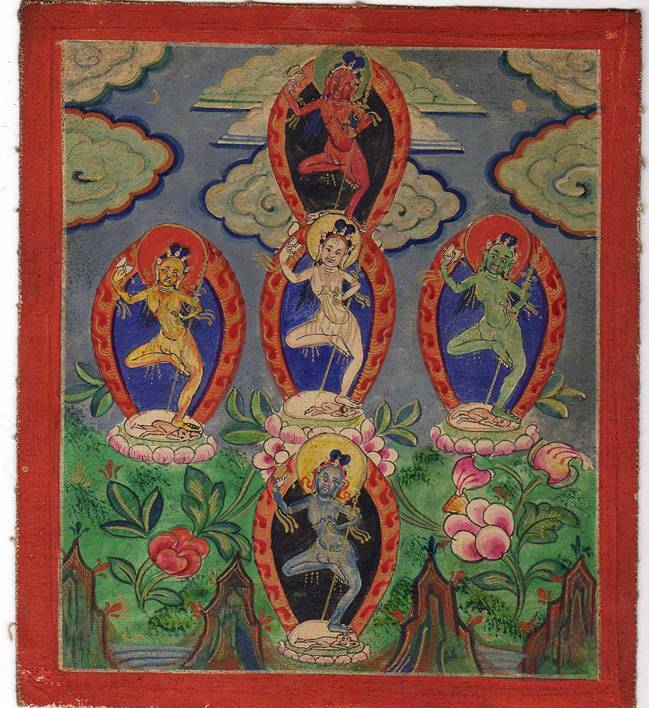
Wisdom Dakinis Dance on the Perfection of Sunyata
Wisdom Dakinis are fully Enlightened. Pema Khandro Rinpoche, explains,
“The notion of Dakini in the Great Perfection (Dzogchen) goes hand in hand with the teachings of the five elements and the five wisdoms. Each of these are represented by a variety of enlightened female figures, known as Dakinis, the Five Wisdom Dakinis.”[3]
Here, we’re focused only on Wisdom Dakinis, or Enlightened Dakinis. Just as people — or gods, or any being — can be either worldly (unenlightened) or “Enlightened” the same is true of Dakinis. Although we may have occasion to “run across” worldly Dakinis, in Buddhist practice, we are only concerned in this feature (and in most practices) with Wisdom Dakinis. [For more on Worldly Dakinis see the section below.]

Five Great Mother Dakinis — One with Prajnaparamita
The Five Wisdom Dakinis are also called the Five Great Mother Dakinis, particularly when associated with Chod practices, which normally focus on Prajnaparamita and the Five glorious Great Mother Dakinis.
It would be a mistake to think of these as “individuals” — rather than aspects. In the Chod Sadhana, the visualization describes the main focus as[3]:
“the Great Mother Mahamata Prajnaparamita and the Five Dakinis, who are all one…”
Likewise, Vajrayogini is an aspect of Great Mother (Mahamata) Prajnaparamita, as is Machig Labdron and Tara. Her mantra, therefore the mantra of the Five Great Mothers, is:
Om Gate Gate Paragate Parasamghate Bodhi Svaha
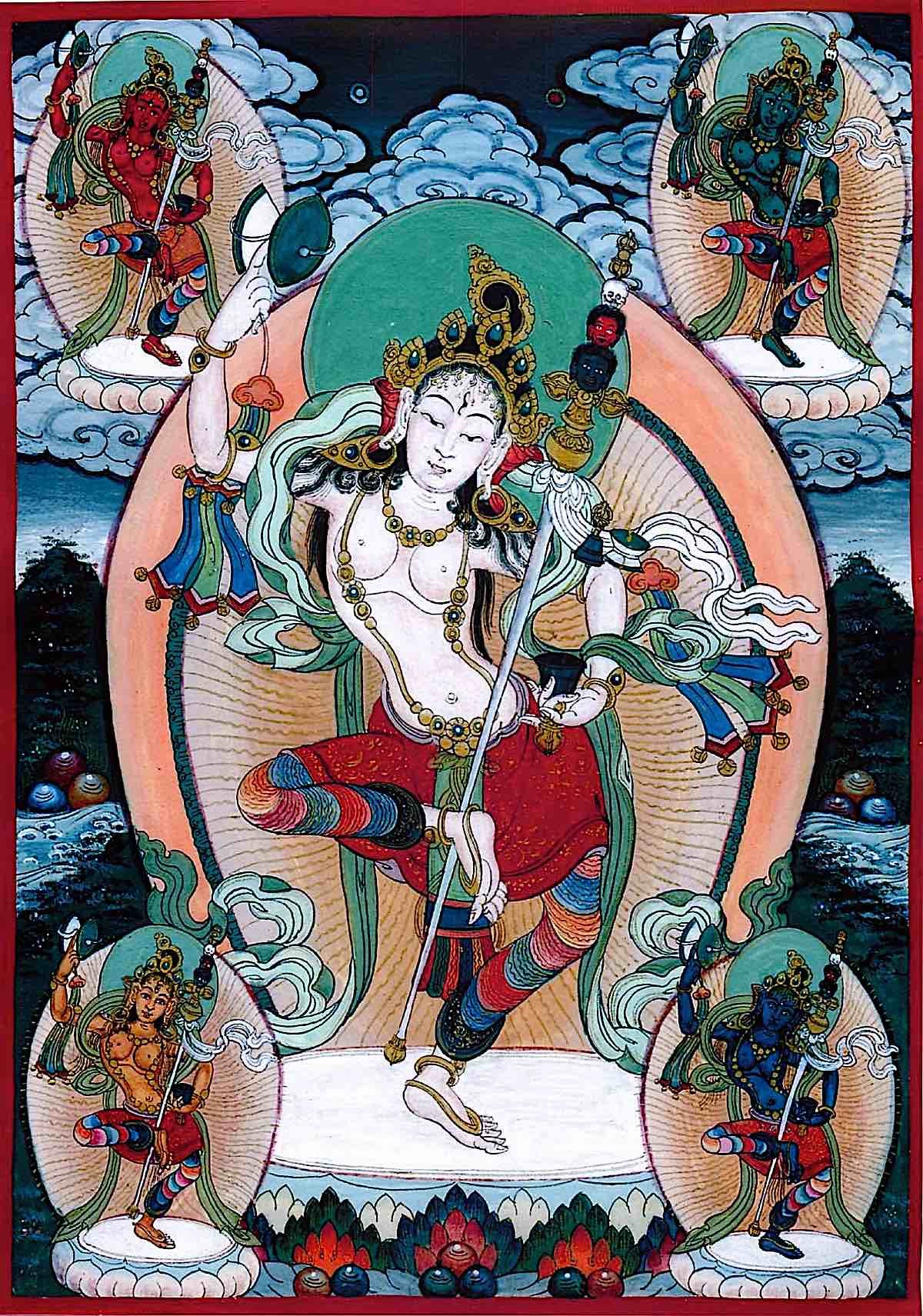
Queen among them — Vajrayogini
Queen among the Wisdom Dakinis is the Sarva Buddha Dakini, Vajrayogini, who is the ultimate expression of Enlightened Wisdom. All other Dakinis are considered to be emanations of Vajrayogini, in the same way the Five Dhyani Buddhas are emanations of Vajradhara (in some traditions Buddha Samantabhadra), the tantric aspect of Buddha Shakyamuni.
Just as there are five Enlightened Buddhas, emanations of Vajradhara, representing the wisdoms that overcome each of the five poisons that afflict us, there are likewise five Wisdom Dakinis — emanations of the great sarvabuddhadakini Vajrayogini.
Summarizing the Five Great Wisdom Dakinis
In Tibetan, the Wisdom Dakinis are called Ye-shes mKha-‘gro lnga, and they are considered to be emanations of Vajravarahi who is an emanation of Vajrayogini. Vajrayogini, of course, is the Sarvabuddhadakini — meaning the “Dakini Whose Essence is That of All Buddhas.”
The five wisdom Dakinis are the “wisdom” counterparts of the Five Dhyani Buddha, who represent “compassion.” As the Enlightened Path includes both wisdom and compassion, these are inseparable — which is why the metaphor used is “consort.” Whether wisdom is the consort of compassion, or the reverse, is not important. It would better, perhaps, in modern context to think of them as co-equal aspects of one Enlightened concept.
Often, our teachers will recommend focusing on one Buddha family — which might include the associated Wisdom Dakini, Dhyani Buddha and usually a family-associated Yidam (for example, Chenrezig or Hayagriva for Padma or Amitabha family).
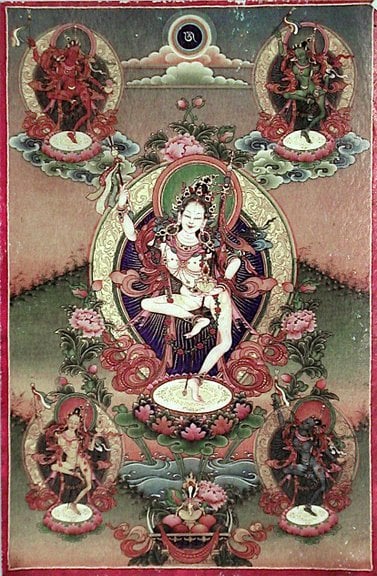
Attributes and Elements
As with the Five Dhyani Buddhas, each of the Wisdom Dakinis likewise pacifies one of the five poisons (listed below under each of the Dakinis) and also focuses on one of the elements and one of the “Energies.”
Tor this list, we arbitrarily ordered this as Body, Speech, Mind, Senses, Activity. Most people likely would think in terms of directional order (usually we place the direction of our main Yidam in front of us, in my case WEST (which I’m using here). You could resort with East in front of you, if Buddha Dakini, Medicine Buddha were your Yidams). Using West in front of you, these are sorted clockwise:
Directions of the Five Wisdom Dakinis
- Center: White Vajra Dakini (with Vairochana Buddha)
- West — Red Padma Dakini (with Amitabha Buddha)
- North (clockwise from West) — Green Karma Dakini (with Amoghasidhi Buddha)
- East — Blue Vajra Dakini (with Akshobya Buddha)
- South — Yellow Ratna Dakini (with Ratnasambhava Buddha)
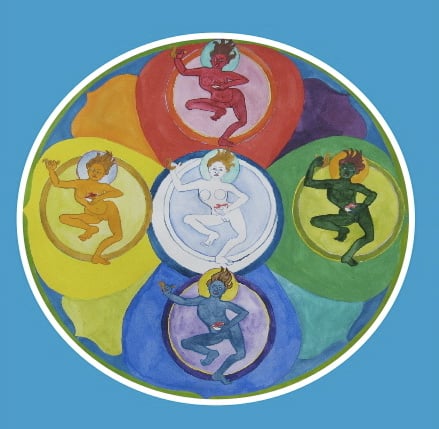
Energies of the Five Dakinis
Energies connote (identical to the associations for the five Buddhas of similar colors) (here the order is Body, Speech, Mind, Senses, Activity, which continues for remaining lists of attributes):
- Body — White Vajra Dakini
- Speech — Red Padma Dakini
- Mind —Blue Buddha Dakini
- Senses — Yellow Ratna Dakini
- Activity (or Karma)
Skandhas of the Five Wisdom Dakinis
- Form — White Vajra Dakini
- Perception — Red Padma Dakini
- Consciousness — Blue Vajra Dakini
- Feelings — Yellow Ratna Dakini
- Formations — Green Karma Dakini
Wisdom of the Five Dakinis
Each Dakini, as the Wisdom counterparts of the Dhyani Buddhas, also specializes in a different “wisdom”
- Dharmadatu — White Vajra Dakini
- Mirror-Like Wisdom — Red Padma Dakini
- Mirror-Like Wisdom — Blue Vajra Dakini
- Equality (Equanimity) Wisdom — Yellow Ratna Dakini
- All-Accomplishing — Green Karma Dakini
Buddha (Compassion Aspect) Counterpart of the Five Dakinis
Each Dakini’s compassion (method) counterpart is one of the Five Dhyani Buddhas:
- Vairochana — White Vajra Dakini
- Amitabha — Red Padma Dakini
- Akshobya — Blue Vajra Dakini
- Ratnasambhava — Yellow Ratna Dakini
- Amoghasidhi — Green Karma Dakini
Poisons of focus by the Five Dakinis
Each Dakini’s focuses on a particular “poison” of the five poisons — Ignorance, Anger, Pride, Desire, Jealousy:
- Ignorance / Delusions — White Vajra Dakini
- Desire/ Attachments — Red Padma Dakini
- Anger — Blue Vajra Dakini
- Pride — Yellow Ratna Dakini
- Jealousy — Green Karma Dakini

Illustrations in this feature by the amazing artist Laura Santi, used with permission. Please do not reproduce. Thankyou. If you are interested in her wonderful Dharma art, visit Laura Santi Sacred Art on Etsy>>
Mother and Father Tantra
Although there’s much more to be understood from the concepts of Father and Mother Tantra — exclusively found in Highest Yoga Tantra of Vajrayana Buddhism — it’s important to understand that Father Tantra does not mean “male deity” practice any more than Mother Tantra stands for “female deity” practice. Chakrasamvara, for example, is a male Highest Yoga Tantra Buddha emanation focused on Wisdom — specifically Clear Light and Shunyata-oriented practices (wisdom). Father Tantra is any Highest Yoga Tantra practice focused on “Illusory Body” and “Compassion” as the main meditative aspect.
The Five Wisdom Dakinis, however, are clearly focused on Wisdom, therefore Mother (not by virtue of apparent visualized sex, but by virtue of focus of practice). The Five Dhyani Buddhas, on the other hand, focus on Compassion and method, although the “poison” and the “wisdom” are the same.

Summary: Five Great Wisdom Dakinis
When the Sarva Buddha Dakini (Vajrayogini) emanates elementally, or in the context of focusing on specific poisons, She emanates as the Five Wisdom Dakinis. Likewise, when Vajradhara — the tantra aspect of Shakyamuni Buddha (or, Samantabadhra Buddha in some traditions) — emanates they first emanate as the five Dhayni Buddhas.
The Five Wisdom Dakinis, can be quickly summarized as:

Buddha Dakini Akashadhatvishvari
- Wisdom Dakini of Universal Law
- Usually in the center (or east, as in some systems Vajra Dakini and Buddha Dakini are switched in terms of direction and elemental associations.)
- Seed Syllable: Blue Bam
- Wisdom awareness and Dakini consort of Vairocana’s Buddha
- Buddha Family (Tathagata)
- Pacifies ignorance
- MIND
- White in color
- the element of space or ether. (In some traditions, the center and east positions of both the Dakinis and the Dhyani Buddhas is switched. Alternately, for specific Yidam practices, the Yidam may move to the center of the mandala. For example in Vajrayogini practice, she may move to the center for Her practice, depending on the specific lineage teachings.)

Vajra Dakini Locana
- Dakini of the Mirror-Like Wisdom
- Eastern Dakini
- Seed Syllable White HA
- Pacifies Anger
- BODY
- Wisdom awareness Dakini consort of Akshobya Buddha
- Blue in color
- Element of water (or space, in some systems Vajra Dakini and Buddha Dakini are switched in terms of direction and elemental associations.)
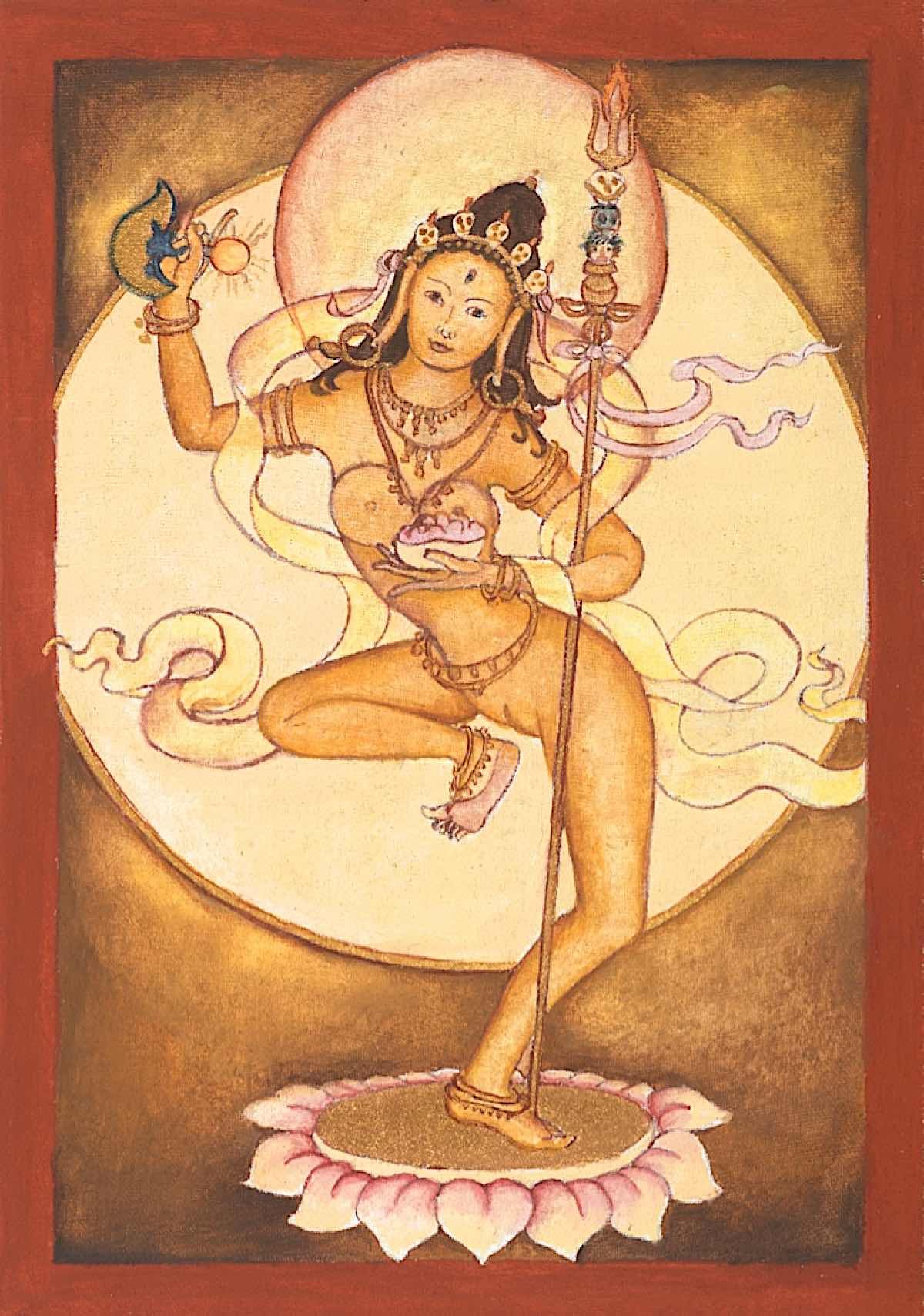
Ratna-Dakini Mamaki
- The Dakini of the Wisdom of Equality
- Southern Dakini
- Dakini consort of Ratnasambhava Buddha
- Buddha Family Ratna
- JEWEL
- EQUALITY wisdom
- Skandha of FEELING
- Poison of Pride
- Yellow in color
- Element of earth.
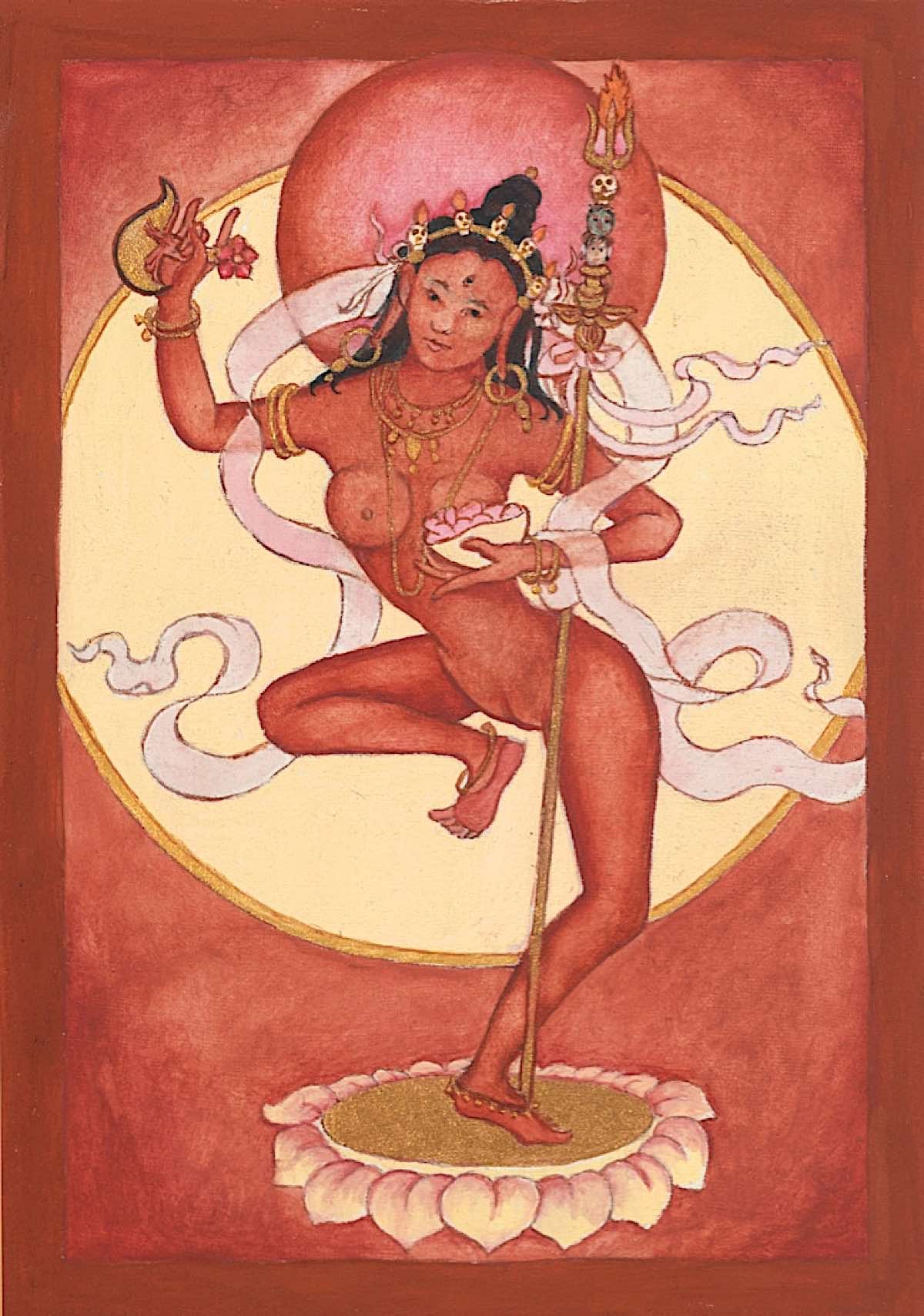
Padma-Dakini Pandaravasini Pandara
- Dakini of the Wisdom of Discernment
- Western Dakini
- Dakini consort of Amitabha
- PADMA (Lotus) Family
- SPEECH
- Pacifies Attachment and Desires
- Skandha of Perception
- Wisdom of Discernment
- Red in color
- Element of fire.

Karma-Dakini Samaya Tara
- The Wisdom Dakini of Activity and Accomplishment
- Northern Dakini
- Dakini consort of Amoghasiddhi
- Karma Family
- ACTIVITY (Karma)
- WISDOM All-Accomplishing
- Skandha of Formations
- Green in color
- Element of air/wind. [2]
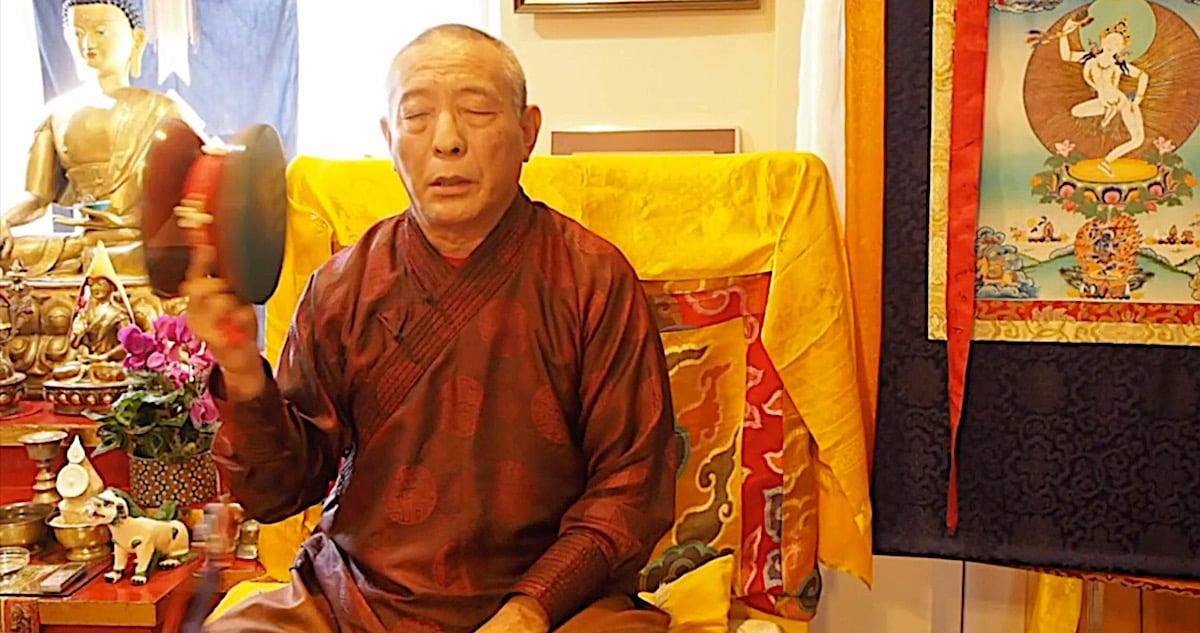
Worldly Dakinis are not Wisdom Dakinis
Much of the misinterpretation of Dakinis arises from the “sky-goer” translation of the name. In many early western translations, this was associated with the idea of “angels” or “messengers” — which doesn’t fit the Wisdom Dakini except in the loosest possible sense.
Dakinis are certainly no angels, even in their Wisdom form. The Wisdom Dakinis certainly embody Wisdom — which means they far surpass the non-Enlightened angel. The sky they dance on is Sunyata, emptiness. They have overcome the kleshas, the poisons, transformed by the luminous energy of Wisdom and non-dual awareness. They are Enlightened Buddhas. (The Worldly Dakinis, which is not the topic for this feature, are just like us — unenlightened.)
The “sky goer” translation is perhaps better translated as “Sunyata dancer” or “Movement in Emptiness” or any other lofty, esoteric translation, In truth, a handful of words can never describe the Wisdom Dakini — which is further confused by the notion of “worldly dakinis” — who, in turn, become vilified with translations such as “zombie” or “cannibal” or “sorceress.” A Dakini is none of these things — but can also be all of these things. It’s like describing a phoenix as a bird.
Wisdom Dakini, if they can be brought down to a few words might be best translated as “dancers on Sunyata, the insubstantiality of all phenomenon, where all manifestations are possible.”
They can be a “being” or a “notion” or an “energy” or a “symbol” or a “consort” or a “wisdom” or a…. you get the idea. Dakinis far surpass any attempt to pin them down to a few words of description.

NOTES
[1] Dakini Activity: The Dynamic Play of Awakening, by Padmsambhava, the Lotus Born. On Amazon>> (affiliate link.)
- Publisher : Rangjung Yeshe Publications (Sept. 27 2018)
- Language : English · Paperback : 194 pages · ISBN-10 : 0997716274 · ISBN-13 : 978-0997716276
[2] Summary of Dakini attributes from “Five Wisdom Dakinis”
[3] “Dakini Wisdom”
[4] Short Sadhana for Chod Retreat by Ge.Lhung Dharma Bhadra of Nyul.Chu at the mountain cave of Nyul.Chu at the request of the most devoted beautiful nun Getsulma Kelsang Cho Kyed. Translated by Ven Zasep Rinpoche, Gaden for the West
More articles by this author

Guru Rinpoche is ready to answer and grant wishes: “Repeat this prayer continuously” for the granting of wishes

VIDEO: Vajrapani Vajra Armor Mantra: Supreme Protection of Dorje Godrab Vajrakavaca from Padmasambhava
Search
Latest Features
Please support the "Spread the Dharma" mission as one of our heroic Dharma Supporting Members, or with a one-time donation.
Please Help Support the “Spread the Dharma” Mission!

Be a part of the noble mission as a supporting member or a patron, or a volunteer contributor of content.
The power of Dharma to help sentient beings, in part, lies in ensuring access to Buddha’s precious Dharma — the mission of Buddha Weekly. We can’t do it without you!
A non-profit association since 2007, Buddha Weekly published many feature articles, videos, and, podcasts. Please consider supporting the mission to preserve and “Spread the Dharma." Your support as either a patron or a supporting member helps defray the high costs of producing quality Dharma content. Thank you! Learn more here, or become one of our super karma heroes on Patreon.
Lee Kane
Author | Buddha Weekly
Lee Kane is the editor of Buddha Weekly, since 2007. His main focuses as a writer are mindfulness techniques, meditation, Dharma and Sutra commentaries, Buddhist practices, international perspectives and traditions, Vajrayana, Mahayana, Zen. He also covers various events.
Lee also contributes as a writer to various other online magazines and blogs.








